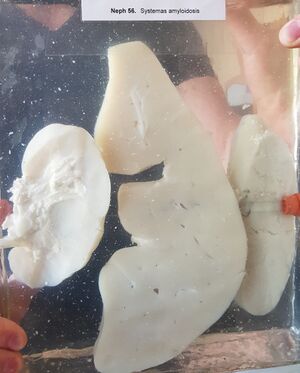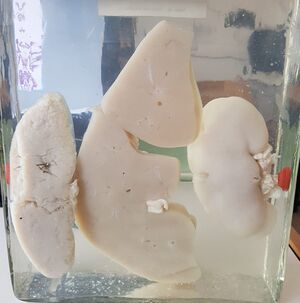12. Systemic amyloidosis
Organ: Kidney, liver, pancreas (or spleen)
Description:
The preparation contains slices of kidney (left), liver (centre), pancreas (right). All three organs have a greyish-whitish and have a rubber-like look.
Diagnosis: Systemic amyloidosis
Causes:
- Systemic AL-type (primary amyloidosis)
- Plasma cell tumour
- Systemic AA-type (secondary amyloidosis)
- Chronic inflammation
- Inflammatory bowel disorders
- Tuberculosis
- Rheumatoid arthritis
- Systemic lupus erythematosus
Theory:
Amyloidosis is a disease where there is deposition of amyloids in many organs. Amyloids are formed by accumulation of misfolded proteins. These misfolded proteins have a crossed β-sheet structure. These β-sheets have a property called birefringence, meaning that they can easily be seen in a polarizing microscope. A special staining called Congo red stain can be used to increase the birefringence of the amyloids, which become green under a polarizing microscope.
Amyloidosis can affect theoretically any organ, but the following organs are most commonly affected:
- Heart
- Causing cardiomyopathy
- Gastrointestinal tract
- Leading to malnutrition, diarrhoea
- Liver and spleen
- Causes enlargement and rubber-like consistence
- Kidney
- Renal failure
- Tongue
- Easy to biopsy to confirm amyloidosis
See theoretical topic 16 for more details on amyloidosis.
It’s important to note that the amyloids themselves aren’t toxic. They’re dangerous for tissues because they occupy the interstitial space which causes compression of the nearby cells and capillaries, damaging them.
There is controversy among the teachers as to whether the last organ is a spleen or pancreas. Some notes and teachers say one thing, and some say the other. I think most say that it's the spleen, though.


